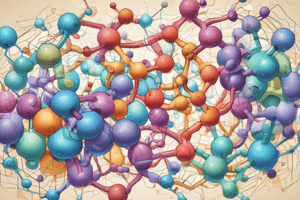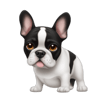Podcast
Questions and Answers
What is the definition of a tripeptide?
What is the definition of a tripeptide?
- A peptide consisting of 5 amino acids
- A peptide consisting of 10 amino acids
- A peptide consisting of 3 amino acids (correct)
- A peptide consisting of 2 amino acids
What type of bond links amino acids in a peptide chain?
What type of bond links amino acids in a peptide chain?
- Ionic bond
- Peptide bond (correct)
- Hydrogen bond
- Disulfide bond
Which amino acid serves as the N terminal amino acid in a polypeptide?
Which amino acid serves as the N terminal amino acid in a polypeptide?
- Any amino acid within the sequence
- Free amino group on the left side (correct)
- Middle amino acid in the sequence
- Free carboxylic group on the right side
What function does the peptide Anserine serve?
What function does the peptide Anserine serve?
How does electrophoresis separate particles?
How does electrophoresis separate particles?
What is the structural composition of keratin?
What is the structural composition of keratin?
Which of the following proteins is known to be a motor protein?
Which of the following proteins is known to be a motor protein?
What type of secondary structure is more stable due to inter-chain hydrogen bonds?
What type of secondary structure is more stable due to inter-chain hydrogen bonds?
Which of the following describes anti-parallel pleated sheets?
Which of the following describes anti-parallel pleated sheets?
Which protein is NOT a component of connective tissue?
Which protein is NOT a component of connective tissue?
What is the primary function of hemoglobin?
What is the primary function of hemoglobin?
Which type of structure is characterized by hydrogen bonds between –N–H groups and –C=O groups?
Which type of structure is characterized by hydrogen bonds between –N–H groups and –C=O groups?
What stabilizes the α-helix structure?
What stabilizes the α-helix structure?
Which of the following proteins primarily serves a structural function in the skin and bone?
Which of the following proteins primarily serves a structural function in the skin and bone?
Which function is associated with lipoproteins?
Which function is associated with lipoproteins?
What determines the function of a specific protein?
What determines the function of a specific protein?
What is the role of ribonuclease?
What is the role of ribonuclease?
Which amino acid property contributes to the formation of a β-pleated sheet?
Which amino acid property contributes to the formation of a β-pleated sheet?
What is the primary shape of an α-helix?
What is the primary shape of an α-helix?
How many amino acids typically form a complete turn in an α-helix?
How many amino acids typically form a complete turn in an α-helix?
What characterizes an amino acid as amphoteric?
What characterizes an amino acid as amphoteric?
Which of the following statements is true about β-pleated sheets?
Which of the following statements is true about β-pleated sheets?
What is the significance of the isoelectric point (PI) of an amino acid?
What is the significance of the isoelectric point (PI) of an amino acid?
What role does proline play in the formation of turns or bends in protein structure?
What role does proline play in the formation of turns or bends in protein structure?
How is the PI calculated for acidic side chain amino acids such as aspartic acid?
How is the PI calculated for acidic side chain amino acids such as aspartic acid?
In terms of structure location, where are α-helices and β-pleated sheets generally found in proteins?
In terms of structure location, where are α-helices and β-pleated sheets generally found in proteins?
What is the PI of alanine if pKa1 = 2.34 and pKa2 = 9.69?
What is the PI of alanine if pKa1 = 2.34 and pKa2 = 9.69?
Which statement is true regarding zwitterions?
Which statement is true regarding zwitterions?
What is the charge of glutamate at its isoelectric point (given pKa1 = 2.2, pKa2 = 9.7, pKa side chain = 4.3)?
What is the charge of glutamate at its isoelectric point (given pKa1 = 2.2, pKa2 = 9.7, pKa side chain = 4.3)?
How many amino acids typically form a protein?
How many amino acids typically form a protein?
Which of the following statements is false regarding proteins and amino acids?
Which of the following statements is false regarding proteins and amino acids?
Flashcards
Peptide
Peptide
A compound formed of less than 50 amino acids linked by peptide bonds.
Dipeptide
Dipeptide
A peptide with two amino acids.
Tripeptide
Tripeptide
A peptide with three amino acids.
Oligopeptide
Oligopeptide
Signup and view all the flashcards
Polypeptide
Polypeptide
Signup and view all the flashcards
Peptide bond
Peptide bond
Signup and view all the flashcards
Primary structure
Primary structure
Signup and view all the flashcards
N-terminal amino acid
N-terminal amino acid
Signup and view all the flashcards
C-terminal amino acid
C-terminal amino acid
Signup and view all the flashcards
Electrophoresis
Electrophoresis
Signup and view all the flashcards
Ion exchange chromatography
Ion exchange chromatography
Signup and view all the flashcards
Zwitterion
Zwitterion
Signup and view all the flashcards
Isoelectric point (pI)
Isoelectric point (pI)
Signup and view all the flashcards
Amino Acid Properties
Amino Acid Properties
Signup and view all the flashcards
Acidic Side Chain
Acidic Side Chain
Signup and view all the flashcards
Basic Side Chain
Basic Side Chain
Signup and view all the flashcards
Protein
Protein
Signup and view all the flashcards
Enzyme
Enzyme
Signup and view all the flashcards
Hemoglobin
Hemoglobin
Signup and view all the flashcards
Antibodies
Antibodies
Signup and view all the flashcards
Primary Protein Structure
Primary Protein Structure
Signup and view all the flashcards
Secondary Protein Structure
Secondary Protein Structure
Signup and view all the flashcards
alpha Helix
alpha Helix
Signup and view all the flashcards
Beta pleated sheet
Beta pleated sheet
Signup and view all the flashcards
Study Notes
Peptides
-
Peptides are compounds formed of less than 50 amino acids linked by peptide bonds.
-
Types of peptides:
- Dipeptide: 2 amino acids.
- Tripeptide: 3 amino acids.
- Oligopeptide: 3-10 amino acids.
- Polypeptide: 10-50 amino acids.
-
One amino acid substitution in a polypeptide's bonding sequence can alter the protein's shape and function.
Peptide Bond
-
The peptide bond, a covalent chemical bond, is formed via dehydration (condensation reaction).
-
It is created when the COOH group of one amino acid reacts with the NH2 group of another amino acid.
-
The polypeptide chain is referred to as the protein's primary structure.
Primary Structure
-
The primary structure is the linear sequence of amino acids.
-
The N-terminal amino acid has a free amino group and always faces left.
-
The C-terminal amino acid has a free carboxylic group and always faces right.
Peptide Functions
- Anserine: reduces muscle fatigue and has buffering capacity.
- Aspartame: artificial sweetener.
- Glutathione (GSH): defense mechanism against toxic compounds and antioxidant activity.
- Bradykinin: inflammatory mediator, vasodilator, and decreases blood pressure.
Protein Separation
-
Electrophoresis: depends on charged particles moving towards electrodes under electrical current influence.
-
Ion exchange chromatography: depends on differences in net charges of proteins at a given pH.
Amino Acid Properties
-
Amino acids can be ionic with a positive and negative charge at physiological neutral pH (pH=7).
-
The carboxylic group dissociates, forming a negatively charged carboxylate ion (COO-).
-
The amino group is protonated, forming a positively charged ion (NH3+).
-
This characteristic is known as amphoteric: organic substance that acts as both an acid and a base.
Zwitterions
-
A zwitterion is an amino acid with both positive and negative charges, making it electrically neutral (net charge is zero).
-
Zwitterions cannot migrate in an electric field.
Isoelectric Point (PI)
-
The PI is the pH where a zwitterion forms.
-
It is at the midpoint between the pKa values of the COOH and NH2 groups.
-
Example: Calculate the PI of alanine with pKa1=2.34 and pKa2=9.69.
- PI (pH) = (2.34 + 9.69) / 2 = 6.105.
- At this PI, alanine has a net charge of zero, is least soluble in water, and does not migrate in an electric field.
Calculating PI for Various Amino Acids
-
Acidic side chain (Asp and Glu): average the side chain pKa with the α-COOH pKa.
-
Basic side chain (His, Arg, and Lys): average the side chain pKa with the α-NH3 pKa.
-
Other ionizable groups (Tyr and Cys): determine the middle pKa and average it with the α-COOH pKa.
-
Example: Calculate the PI of glutamate with pKa1=2.2, pKa2=9.7, and pKa side chain=4.3.
- PI (pH) = (2.2 + 4.3) / 2 = 3.25.
- At this PI, glutamate has a net charge of -1.
Amino Acid PKa Values
- Note the pKa values for various amino acids:
- Gly: pKa1 = 2.35, pKa2 = 9.78, PI = 6.07.
- Asp: pKa1 = 2.10, pKa2 = 9.82, pKa3 = 3.86, PI = 2.98.
- Lys: pKa1 = 2.18, pKa2 = 8.95, pKa3 = 10.53, PI = 9.74.
- Cys: pKa1 = 1.86, pKa2 = 10.25, pKa3 = 8, PI = 4.93.
- Tyr: pKa1 = 2.2, pKa2 = 9.11, pKa3 = 10.07, PI = 5.66.
Proteins
-
Proteins are high molecular weight macromolecules formed of more than 50 amino acids linked by peptide bonds.
-
Some proteins are formed of two or more polypeptide chains.
Protein Functions
-
Enzymes: catalytic function.
-
Lysozyme: an enzyme that attacks bacteria.
-
Ribonuclease: an important enzyme in RNA metabolism.
-
Hemoglobin: transport function as a carrier of oxygen.
-
Lipoproteins: transport function as carriers of lipids.
-
Glycoproteins: structural function in the cell membrane.
-
Keratin: provides defense against mechanical and chemical injury.
-
Prothrombin: involved in blood clotting.
-
Fibrin: plays a crucial role in forming blood clots.
-
Insulin: hormonal regulation.
-
Collagen: structural function in skin and bone.
-
Ferritin: storage form of iron.
-
Antibodies: defense function.
Protein Structures
- Proteins have four levels of structural organization:
- Primary structure: the linear sequence of amino acids.
- Secondary structure: local folding patterns in a polypeptide chain.
- Tertiary structure: the three-dimensional arrangement of a single polypeptide chain.
- Quaternary structure: the interaction between multiple polypeptide chains to form a complex protein.
Primary Structure
-
It is defined by the number, types, and arrangement of amino acids in the polypeptide chain.
-
Peptide bonds (amide bonds) are the primary type of bond.
-
Peptide bonds are resistant to conditions that denature proteins, such as heating.
-
It is determined by the genetic information present in DNA.
-
Example: Lysozyme, a bacterial attacking enzyme containing 129 amino acids.
Secondary Structure
-
Formed due to hydrogen bonding between hydrogen of NH groups and oxygen of C=O groups in the peptide backbone.
-
Types of secondary structure:
- α-helix: coiled or spiral rod-like shape, stabilized by intrachain hydrogen bonds, and disrupted by helix breakers.
- β-pleated sheet: zigzag sheet-like structure, stabilized by interchain hydrogen bonds, and more stable than the α-helix.
- β-turn or loop: short segments connecting secondary structure units.
α-Helix
- Each turn contains 3.6 amino acids.
- The α-helix is stabilized by intrachain hydrogen bonds formed between –N–H groups and –C=O groups that are four residues back, i.e., –N–H group of a 6th peptide bond is hydrogen bonded to –C=O group of 2nd peptide bond.
- The R-group of amino acids projects outwards of the helix.
- It is disrupted by helix breakers.
- Example: Keratin, a fibrous protein present in hair and skin.
β-Pleated Sheet
-
Two or more polypeptide chains are involved.
-
The hydrogen bonds are interchain hydrogen bonds.
-
Has R groups above and below the sheet.
-
Not susceptible to disruption as the helix.
-
Two types: parallel (chains in the same direction) and antiparallel (chains in opposite directions).
-
Example: Silk fibroin, a fibrous protein found in silk worm fibers.
β-Turn or Loop
- Short segments connecting secondary structures like two adjacent strands of an antiparallel β-sheet.
- Generally, composed of 4 amino acids with one proline (causing a kink in the polypeptide chain) and one glycine (flexible small R group).
- Located in the outer region of a protein.
- Example: Ribonuclease A.
Studying That Suits You
Use AI to generate personalized quizzes and flashcards to suit your learning preferences.





